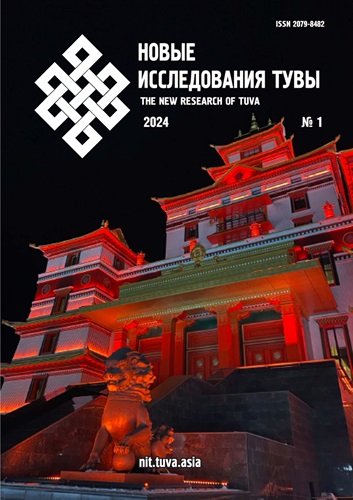Sociological portrait of the single-parent family in the Republic of Tuva
DOI:
https://doi.org/10.25178/nit.2024.1.12Keywords:
Republic of Tuva; Tuvans; single-parent family; parent; extramarital birth; family sociology; single parentAbstract
The article presents a sociological portrait of the contemporary single-parent family (having children under 18 and one of the parents) in the Republic of Tuva. The analysis is based on the results of the sociological study “Issues of single-parent Families in the Republic of Tuva”, conducted by the authors in 2022 (sample size 1539 individuals), as well as materials from discussions with experts from social protection agencies on family and child welfare in the Republic of Tuva. Marriage and divorce coefficients in the republic were considered and analyzed in comparison with nationwide data.
According to statistical data, the proportion of incomplete families in the total number of families is 6%, but these data do not account for various forms of cohabitation, etc. Among survey participants who are in a registered marriage and have children under 18 (complete family group), 63.1% are represented, while those having children but not in a registered marriage constitute 35.1%. In the overall sample of incomplete family representatives, the figure stands at 17.1%. This is comparable to nationwide indicators, but the structure of incomplete families in terms of the reasons for their formation significantly differs.
The single-parent families are characterized by a more vulnerable position, and they are more likely to be at risk of poverty and social exclusion due to gender inequality. In the single-parent family, the sole parent is typically a working and often additionally part-time employed mother or father who has to compensate for the lack of resources of the other parent. As a parent, she is less likely to take out loans, but may do so for purchasing essential items. To support the family, this parent may sell or pawn personal belongings. In one-third of cases, she is willing to engage in seasonal migration for additional income.
In Tuva, for an incomplete family, the presence of one or two minors is characteristic in more than 70% of cases. In over half of cases, these children are born out of wedlock. The father is known; in one-third of cases, he provides financial support to the family, in less than half — maintains some emotional contact with the children, however, alimony is provided by not even every tenth single mother. Prejudiced attitudes from the surrounding community towards representatives of the single-parent families are not felt by both the adult and the child.
References
Akvazba, E. O. and Skok, N. I. (2020) Modern single-parent families: social aspect. Russian economic bulletin, no. 6, pp. 235–238. (In Russ.).
Gurko, T. A. (1992) Social work program with single-parent families. M.: Ministry of Social Protection of the Population of the Russian Federation, Center for Universal Human Values. 56 p. (In Russ.).
Goncharova, G. S. and Savelyev L. Ya. (2004) Family and marriage relations among the peoples of Siberia: problems, trends, prospects / ed. by Yu. V. Popkov. Novosibirsk, Nonpareil. 288 p. (In Russ.).
Kozlova, E. A. (2020) Specificity of Population Reproduction in the Tyva Republic at the End of the 1980–1990s. Manuscript, vol. 13, no. 9, pp. 39–43. (In Russ.). DOI: https://doi.org/10.30853/manuscript.2020.9.7
Kurbatsky, G. N. (2001) Tuvans in their folklore (historical and ethnographic aspects of Tuvan folklore). Kyzyl, Tuvan book publishing house. 464 p. (In Russ.).
Nafikova, G. Z. (2009) The concept of an incomplete family and its types. Bulletin of the Bashkir University, vol. 14, no. 1, pp. 241–243. (In Russ.).
Nuskhaeva, B. B. (2016) Family with one parent in Kalmykia (based on statistical data). Oriental Studies, vol. 24, issue 2, pp. 167–175. (In Russ.).
Potapov, L. P. (1969) The Tuvans: sketches of the folk lifestyle and related household activities. Moscow, Nauka. 400 p. (In Russ.).
Prokofieva, L. M. and Korchagina, I. I. (2020) Single parent families in Russia: level of spread and material support. International Journal of Humanities and Natural Sciences, no. 9–1 (48), pp. 172–179. (In Russ.). DOI: https://doi.org/10.24411/2500-1000-2020-11006
Reznikov, E. N. and Tovuu, N. O. (2002) Ethnopsychological characteristics of the Tyva people: theory and practice. Moscow, Per Se. 223 p. (In Russ.).
Seregin, A. V. (2020) Revival of marriage sine manu and concubinatus in family law of the XX–XXI centuries: comparative legal analysis. Bulletin of the Faculty of Law of the Southern Federal University, vol. 7, no. 1, pp. 101–104. (In Russ.).
Subbotin, S. V. (2016) Tuvan family and its functions. Traditions and innovations. Bulletin of the Kalmyk Institute for Humanitarian Research of the Russian Academy of Sciences, vol. 9, no. 6 (28), pp. 159–171. (In Russ.).
Tuvans. Native people (2022) / ed. by C. K. Lamazhaa and N. D. Suvandii. St. Petersburg, Nestor-History. 344 p. (In Russ.).
Published
How to Cite
For citation:
Samba A. D.-B., Goliusova Yu. V., Demidov A. A., Ananyeva K. I. and Ondar N. O. Sociological portrait of the single-parent family in the Republic of Tuva. New Research of Tuva, 2024, no. 1, pp. 184-196. (In Russ.). DOI: https://doi.org/10.25178/nit.2024.1.12
Issue
Section

This work is licensed under a Creative Commons Attribution-NonCommercial 4.0 International License.

Author(s) license holder(s) grant rights for their work to the journal (grantee of a license) under the simple non-exclusive open license in accordance with Art. 1286.1 «Open license for a research work, work of literature or fine arts», Civil Code of the Russian Federation.
New Research of Tuva publishes articles under the Creative Commons Attribution-NonCommercial license (CC BY-NC).
Since it is an open license, author(s) reserve the right to upload the article to their institutional repository, submit it to another journal (if it allows republications), or republish it on their own website (in full, or in part).
However, several conditions apply here:
a) The republished version must always contain the name(s) and affiliation(s) of the author(s), the original title and the hyperlink to the original version on the New Research of Tuva website;
b) It must be in open access, free of charge, and no category of readers must be in any way whatsoever advantaged over general readership.
c) should the contribution be submitted elsewhere by its author(s) without substantial modification (30% or more of original text unchanged), the body of the article should contain a disclaimer that the original version was published in New Research of Tuva (with a link to the respective page)
The CC-BY-NC is a non-revocable license which applies worldwide and lasts for the duration of the work’s copyright.













